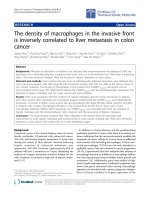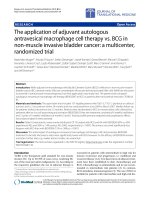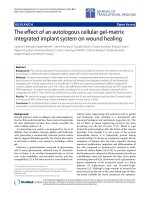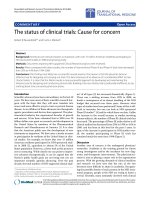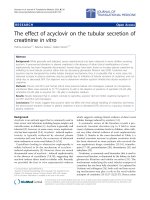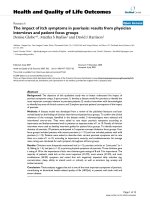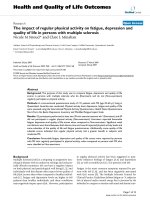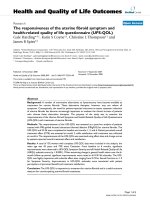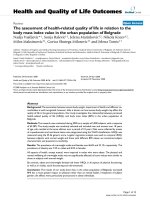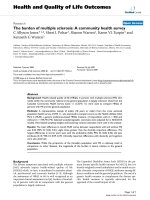báo cáo hóa học:" The experiences of people living with HIV/AIDS and of their direct informal caregivers in a resource-poor setting" doc
Bạn đang xem bản rút gọn của tài liệu. Xem và tải ngay bản đầy đủ của tài liệu tại đây (560.69 KB, 9 trang )
Majumdar and Mazaleni Journal of the International AIDS Society 2010, 13:20
/>Open Access
RESEARCH
© 2010 Majumdar and Mazaleni; licensee BioMed Central Ltd. This is an Open Access article distributed under the terms of the Creative
Commons Attribution License ( which permits unrestricted use, distribution, and repro-
duction in any medium, provided the original work is properly cited.
Research
The experiences of people living with HIV/AIDS
and of their direct informal caregivers in a
resource-poor setting
Basanti Majumdar*
†1
and Nomathemba Mazaleni
†2
Abstract
Background: HIV/AIDS is a critical concern in South Africa, where extreme poverty and gender issues are major
determinants of health. A comprehensive home-based care programme is needed to lessen the burden placed on the
caregivers of those suffering from HIV/AIDS. The purpose of this study was to explore and describe the challenges
faced by people who are living with HIV/AIDS and by their caregivers in resource-poor, remote South African villages.
Methods: In-depth interviews were conducted with nine persons living with HIV/AIDS and their nine direct informal
caregivers. Interviews explored the themes of physical, emotional and social wellbeing. Two focus groups, one
involving community leaders and one with local health care providers, were conducted to build on themes emerging
from the in-depth interviews. A thematic analysis of the transcripts was performed.
Results: This study sheds light on the needs of persons living with HIV/AIDS and the needs of their direct informal
caregivers in a rural area of the Eastern Cape province of South Africa. These needs include: physical/medical, social,
material, financial, physiological/emotional, gender issues, and instrumental.
Conclusions: In developing home-based care programmes, it is vital to consider the perceived needs of persons living
with HIV/AIDS and their direct informal caregivers. The results from this study serve as a basis for the development of a
home-based care programme in one resource-poor setting of South Africa and could provide a model for such
programmes in similar areas.
Background
The latest AIDS Epidemic Update, published by the Joint
United Nations Programme on HIV/AIDS (UNAIDS)
and the World Health Organization (WHO), estimates
that 33.2 million people were living with HIV in 2007 [1].
With an estimated 5.5 million people infected [2], South
Africa is burdened with the largest HIV-infected popula-
tion in the world [1].
Although South Africa is considered to be a middle-
income country, it has one of the highest levels of income
inequality in the world. While the wealthiest 10% of the
population account for 51% of the country's income, the
poorest 10% account for only 0.2% [3]. Despite post-
apartheid policies that have increased health spending in
poor districts, rural and African residents bear the largest
burden of illness [3,4]. Conditions created by apartheid,
such as migrant labour and underdeveloped health ser-
vices for African people, have resulted in an environment
that allows for the efficient transmission of HIV [3,5].
The rapid spread of HIV throughout SA has created a
burden on the already underdeveloped public health care
delivery system [4]. Hospitals and tertiary care facilities
are becoming increasingly unable to care for their HIV/
AIDS patients [6]. Although post-apartheid policies have
aimed to redistribute spending to primary health care,
this section of the health system remains inadequately
funded and resourced [3-5,7]. Consequently, much of the
burden of caring for those infected with HIV/AIDS falls
onto households and communities [8-10].
In its Operational Plan for Comprehensive HIV and
AIDS Care, Management and Treatment for South Africa
the South African government (2003) stated that one of
* Correspondence:
1
Master University, School of Nursing and Department of Family Medicine,
Hamilton, Ontario, Canada
†
Contributed equally
Full list of author information is available at the end of the article
Majumdar and Mazaleni Journal of the International AIDS Society 2010, 13:20
/>Page 2 of 9
its major goals was to provide adequate community-
based treatment, care and support services for people liv-
ing with HIV/AIDS (PLHIV) before the end of the decade
[11]. Community-based home care (CBHC) programmes
in the country have since been bolstered by increased
government grants and training for community health
workers [12]. CBHC services are an integral and afford-
able part of a national strategy to address the multi-
dimensional needs of those affected by HIV/AIDS
[2,8,13].
Support services for PLHIV and their direct informal
caregivers (DICGs) must be developed based on research
examining: the current state of accessible health care in
their communities; the health conditions of PLHIV; and
mitigating social factors.
The purpose of this paper is to describe the major find-
ings of a qualitative descriptive study conducted in 2002.
The study identified the needs of PLHIV and their DICGs
through an examination of the day-to-day experiences of
PLHIV in rural Eastern Cape, South Africa. The needs of
PLHIV and their DICGs have formed the foundation for
the development of a model of community-based home
care that could be applied in order to alleviate some of
these needs. The scope of this paper is to present the
identified needs of the PLHIV and their DICGs.
Methods
Purpose
The purpose of the current study was to explore and
describe the challenges faced by PLHIV and their DICGs
in two remote South African villages, and their ability to
cope with the illness given the scarce social and economic
resources within their communities.
Ethics
Research Ethics Boards in Canada and South Africa
granted approval for this project. Nurses from the local
health centres held community meetings to inform com-
munity members of the study. Additionally, the study
received approval from the community chief and elders.
All participants gave their written informed consent prior
to participating in the study. Consent forms were written
in the local language of isiXhosa.
Timeline
Data collection took place in 2002 during a three-week
period.
Study site
The project was conducted in two isolated rural town-
ships of the Eastern Cape, an impoverished province with
a high unemployment rate. In 2000, the Eastern Cape was
home to 6.82 million people, with 85% of the population
being African and 65% of the population living in rural
areas [14]. The poverty rate in the Eastern Cape (68.7%) is
the highest in the country. A wide disparity exists among
the population: there are very low levels of poverty
among white people, but a 73.8% rate among African
people [14]. Poverty is also a rural phenomenon in this
province, with the rural poverty rate estimated at 82.2%,
compared to 42.1% in urban areas [14].
A high prevalence of HIV is found in the Eastern Cape.
By mid-2006, 19.2% of adults aged 20-64 (17.2% men vs.
20.9% women) in the province were living with HIV [15].
The two rural townships selected for this study repre-
sent isolated communities facing problems of HIV/AIDS
and poverty, and thus could serve as models for similar
areas. The two sites had populations of 18,519 (Township
A) and 6,845 (Township B). Township A was equipped
with a primary health care centre with full-time nursing
staff. Township B was equipped with a community care
centre, staffed by community members and visited by a
nurse three days per week.
These government-funded clinics are mandated to
meet the immediate health care needs of the area. Indi-
viduals who require the care of a physician must travel to
the closest government hospital. While visits to the local
clinics were free, at the time of this study, a visit to the
local hospital cost eight rand (R), about US$1.
Sample selection
In each rural township, community workers from the
local health centre recruited PLHIV and their respective
DICGs to participate in in-depth, individual interviews.
PLHIV selected for participation met the criteria that: (a)
they had been diagnosed with HIV; and (b) they could
identify one person who provided them with informal
care. Each participating PLHIV identified a person who
provided him or her with informal care for inclusion in
the study.
Data collection
Semi-structured interviews were conducted concurrently
with each PLHIV and his or her DICG by two graduate
students working with the research team. Interviews were
conducted using an interview guide containing both
close-ended demographic questions and open-ended
questions addressing the themes of physical, mental and
emotional health. To limit intrusion into private house-
holds and protect confidentiality, participants were given
the choice of being interviewed in their home or at the
local health centre.
Four community workers from the local health centres
translated consent forms and interview guides from Eng-
lish to isiXhosa, and acted as translators during inter-
views. These four volunteers were fluent in both English
and isiXhosa. At the end of the interview, participants
Majumdar and Mazaleni Journal of the International AIDS Society 2010, 13:20
/>Page 3 of 9
received a food package as an appreciation for their time.
Participants were not told ahead of time that they would
receive this food package.
Focus group interviews
Two focus group interviews were conducted to build on
themes emerging from the in-depth interviews. Partici-
pants of the first focus group had a background in health
care and experience in caring for patients with HIV/
AIDS. Participants of the second focus group were identi-
fied as leaders in their community. Focus group inter-
views were conducted by two graduate students working
with the research team, using interview guides written in
English. The health care provider focus group was con-
ducted in English and lasted for two hours. The commu-
nity leader focus group was conducted in isiXhosa, with
community workers from the local health centre acting as
translators, and lasted for four hours.
Data analysis
All interviews and focus groups were tape-recorded with
the permission of the participants. Tapes were tran-
scribed verbatim, and those conducted in isiXhosa were
translated to English. Local research team members car-
ried out translation and validation of the transcripts with
the assistance of the translators. Four members of the
research team, two from Canada and two from South
Africa, independently coded and categorized the data. A
very close level of agreement was observed between
researchers. Final themes were decided by consensus.
Local project team members then validated the themes
with participants and community stakeholders.
Results
Participant characteristics
Persons living with HIV/AIDS
Seven female and two male PLHIV between the ages of
28 and 42 years participated in the study. The proportion
of female participants outweighed male participants due
to the fact that many males stated that they were not
comfortable being interviewed during the recruitment
process.
Eight participants were single, divorced or widowed,
and one was married. All participants, except one,
reported that they were diagnosed with HIV within the
past two years. The other participant had been diagnosed
with HIV for six years. Four reported that they con-
tracted HIV through unprotected sexual intercourse and
five did not know how they became infected. All partici-
pants were unemployed and dependent on government
disability grants (referred to by participants in this study
as "pensions") or support from family members. Five
PLHIV had recently received or were currently receiving
treatment for tuberculosis.
Direct informal caregivers
All nine participating caregivers were immediate female
family members of the PLHIV and ranged in age from 38
to 74 years. Most were married and had children and a
family to care for, apart from the PLHIV and, in some
cases, the children of the PLHIV. All DICGs relied on
government financial assistance (disability grant, old-age
pension, or care-dependency grants) via a monthly pay-
ment of R620 ($78). The caregivers represented in this
study reflect others from published literature, which have
reported that DIGCs in South Africa tend to be female
family members who are living below the poverty line
[16-18].
Focus group participants
The eight participants of the first focus group had a back-
ground in health care and experience in caring for
PLHIV. The backgrounds of the participants included a
doctor, a social worker, a health promoter from the Pro-
vincial Department of Health, three nurses from the local
health centres, the matron and supervisor of the health
centres, and a teacher and coordinator of the primary
school education programme which provides support to
children affected by HIV/AIDS.
The 18 participants of the second focus group were
identified as community leaders. Participants included 13
respected elders, one religious official, one political coun-
cillor, and three volunteer HIV/AIDS workers. The com-
munity leader focus group was larger than the traditional
size of six to 12 members in order to accommodate the
numbers of community leaders who expressed interest in
participating.
Themes from the data
Themes that emerged through in-depth interviews with
PLHIV and DICGs, as well as the two focus groups, can
be broadly categorized as: (1) needs of the PLHIV and
their DICGs; and (2) necessary components of a commu-
nity-based home care programme. The focus of this
paper is to present the needs of the PLHIV and their
DICGs. These needs include: physical/medical, social,
material, financial, physiological/emotional, gender
issues, and instrumental.
Physical/medical issues
All PLHIV reported deterioration in physical health due
to their illness. Most suffered from lack of appetite, tired-
ness and pain. Participants reported that they visited the
local health centre if they felt ill, and received medication
to treat their symptoms. None of the PLHIV were under-
going antiretroviral treatment at the time of the inter-
views. Diarrhoea, fatigue, pain, rashes, and headaches
were common symptoms and deteriorating health made
it difficult for some participants to maintain their pre-
diagnosis activity level:
Majumdar and Mazaleni Journal of the International AIDS Society 2010, 13:20
/>Page 4 of 9
I used to do everything in my house myself. Now, I
feel pain in my feet and I get tired. (PLHIV)
I forced [myself] to make [things] but sometimes, the
body becomes very painful. (PLHIV)
Focus group participants also spoke about their per-
sonal experiences caring for family members infected
with HIV/AIDS and the associated medical symptoms:
But the problem is that when she eats, she has a loose
stool and that makes her weak. She has no strength.
She has lost weight and sometimes she even vomits.
(community leader focus group participant)
In addition to the deteriorating physical health that
PLHIV experience, DICGs also reported stress-related
physical symptoms, including headaches, lack of sleep,
body pain and abnormal blood pressure. One DICG
explained the burden put on her to continue providing
care despite the toll on her personal health:
I am tired all the time and my body is full of pains.
Even if I am tired, I say that I must continue the work
because there is nobody else who is taking care of
them. (DICG)
PLHIV and their DICGs expressed an obvious need for
physical and medical assistance to cope with symptoms
of HIV/AIDS, but interviewees could name few commu-
nity resources available to assist them. Although partici-
pants named the local health centre as their primary
source of medical assistance, participants also described a
shortage of staff within the centre and an occasional
shortage of medications. According to one participant in
a community leader focus group, "The clinic is short of
medicine. Sometimes you get help, sometimes you don't."
In addition to sporadic support from the clinics, partic-
ipants stated that PLHIV living in their communities
were not receiving assistance at home from nurses or
other trained health care workers.
Psychological/emotional Issues
Many PLHIV reported sadness and worry as a result of
their deteriorating health, the grave prognosis, and the
fate of their children:
Sometimes I feel sad My health gives me some prob-
lems. I am always thinking of my status. (PLHIV)
Now the days are [worse] than before. I always think
of the disease (PLHIV)
However, while some respondents exhibited despair,
others retained some hope:
I am thinking of my life ahead in the future because I
know it will not be the same as it used to be. I have
good feelings about the future even if I don't know if I
will be there. (PLHIV)
PLHIV coped with the psychological burden that HIV/
AIDS created by learning to accept their status, talking to
family, or drawing support from religion and spirituality.
As one interviewee stated, "Most of the time, I can't sleep.
But after I open up, I feel much better." Another reported,
"Happiness comes in terms of love. I am loved by family
members."
During the interviews, DICGs professed love and sup-
port for the PLHIV, and felt that their care was better
than no care at all. As a DICG said, "I am doing every-
thing because I have to do it. There is nowhere to run
away from the responsibility. I have accepted it as it
comes."
However, caring for the PLHIV results in barriers to
socializing and restricts support networks available to the
DICG. This isolation results in a large emotional burden
for the DICGs:
Due to my emotions I am no longer socializ-
ing Because I just sacrificed for the situation and
taking care of my family, my husband and my chil-
dren. Sometimes I am depressed but have to adjust
myself so that I can go on helping them because I love
them so much. (DICG)
Other caregivers explained:
I don't want to lose hope because I could leave her
behind and die before she does. There is time. (DICG)
There [are] times when I feel I do not know where to
start and where to end. At this point I turn to God to help
us. (DICG)
The psychological and emotional impact of HIV/AIDS
on the PLHIV and his or her DICG can be substantial and
must be addressed. No participants identified the clinic
as a source of emotional support, and researchers were
told that the clinic was short staffed.
PLHIV and DICG identified religion as being very
important. However, the religious organizations within
the community did not appear to reach out to their
impoverished congregations. Participants from the com-
munity leader focus group identified that churches are
beginning to address the psychological and emotional
needs of PLHIV. However, PLHIV who mentioned
"church" as a source of support stated they received only
spiritual support, and most had not disclosed their status
to the priest or congregation.
Social issues
Stigma and isolation were important issues for PLHIV.
Living in a small rural community, participants found it
difficult to hide their HIV status, particularly as their dis-
ease progressed:
People with HIV/AIDS are neglected. You are judged.
They are insulting the person. They hate her. They
don't want to come near her. (PLHIV)
One PLHIV became very emotional and recalled:
They are insulting me. They say I've got the sore
mouth because I've got AIDS The community needs
to be taught how to handle the people with HIV,
because they are always laughing at them and insult-
ing them. When they are talking together and they see
Majumdar and Mazaleni Journal of the International AIDS Society 2010, 13:20
/>Page 5 of 9
me and they are talking about me, this is why I don't
tell anybody. (PLHIV)
As a result of the stigma associated with HIV/AIDS in
the community, support from friends was minimal; sev-
eral of the PLHIV stated that they had no friends or that
their friends were unsupportive. PLHIV and DICGs
pointed to the association between HIV and sexual inti-
macy as the possible root of stigma. As one PLHIV said,
"We are blamed and taken as prostitutes." Focus group
participants also attributed the stigma attached to HIV/
AIDS to its association with sex and sexuality:
To our people, to our neighbours, it's a disgrace if
your child is HIV positive, as if you are the cause of it.
And sometimes you don't know from which direction
it came (community leader focus group)
They say it's because girls don't behave. Girls have a
lot of boys, boys have a lot of girlfriends. And it goes
on like that. (community leader focus group partici-
pant)
Others in the focus group commented on the cultural
customs that restrict sexual behaviour to marital relation-
ships, and that those engaging in sexual relations without
being married are looked down upon. Furthermore, those
who are married and diagnosed as HIV positive are per-
ceived as immoral:
Our culture does not allow for relations before mar-
riage, so when you have AIDS, you feel that you have
done something wrong, unacceptable behaviour. Even
for a married couple, because it means that one has
not been faithful to the partner. (health care provider
focus group participant)
Focus group participants also discussed the implica-
tions of this stigma, including fear of disclosure, the isola-
tion of PLHIV by the community, and silence around
HIV/AIDS:
When they hear that someone has HIV, [people] say,
"I don't want to know this person. I don't want to go
near this person." And they shut the doors of the
community to this person. There is a lot of discrimi-
nation toward HIV-positive people. (community
leader focus group participant)
Fear of stigma and disclosure was heightened among
participants who discussed problems of maintaining pri-
vacy in a small, isolated, rural setting. As the participant's
HIV/AIDS symptoms progressed, hiding his or her HIV
status from the community became increasingly difficult.
In most cases, caregivers displayed complete devotion
to the PLHIV. Though the fear of contracting HIV did
cross their minds, it did not hamper their willingness to
provide care:
We have welcomed our brother because we love him.
There's no other way We decided just to accept him
and love him the way we loved him before. Some-
times, there's a sadness and [we are] downhearted
because it was not easy for us to accept that but, at
last, we accepted (DICG)
Interview and focus group participants believed that
community members' fear of infection promotes stigma.
As one PLHIV said, "People don't care about us. They
don't like us because they think they are going to be
infected." Fear is perpetuated by a lack of education and
information about HIV/AIDS in the community. Partici-
pants believed that further community education could
succeed in removing the stigma attached to HIV/AIDS
and increase community acceptance of those infected and
affected by this illness:
We must have people from the community come
together and talk and discuss and share views on how
to deal with this. We must have traditional healers,
doctors, and others. We have to accept people and get
rid of stigma. This starts at home. We have to accept
family members with HIV/AIDS. (DICG)
Financial
Participants attributed the extreme poverty affecting the
community to the high level of unemployment, as well as
other economic problems plaguing South Africa. "There's
no work. Everybody has very little to live on there's no
money, and the rand is going up and down," a participant
in the community leader focus group said. For those liv-
ing in the area, poverty is exacerbated by drought, which
is afflicting the village and rendering agricultural or farm-
ing activity nearly impossible. According to a community
leader focus group participant, "Now there's a drought,
we have nothing in our gardens."
All PLHIV participating in this study were unemployed
and living in extreme poverty. As one PLHIV stated, "The
money is too little and the family is too big." In one case,
14 people were dependent on one pension and the spo-
radic income of one working adult. A PLHIV stated, " it
doesn't cover to support the children, even no[t] enough
food to be covered." Another PLHIV remarked, "People
are very poor. I would like to have some cattle and some-
thing to plant."
A government grant of R620 was provided to PLHIV on
a monthly basis. However, the processing time for grant-
ing a pension is sometimes unacceptably long and the
amount of pension granted far too low to cover even
basic expenses. In one case:
My daughter who died - they took seven months to
get a grant but she had died by the time the grant
came. I asked her brother to dig into this issue
because I am debt, no money to feed the children.
And they gave me only R1000. Then I applied and got
the R100 and R200 per child. I can't even pay her rent
with this. (community leader focus group participant)
According to participants, poverty leads to poor care
and support of PLHIV as they are unable to access the
treatment and nutrition necessary to maintain their
Majumdar and Mazaleni Journal of the International AIDS Society 2010, 13:20
/>Page 6 of 9
health. On a broader scale, poverty affecting the area
leads to a corrosion of the sense of community that once
existed within the village. Community members do not
have the means to lend support to neighbours who are ill.
"It's very difficult to help someone when you have noth-
ing," a community leader focus group participant said.
Material
Due to the financial drain and limited physical mobility
created by HIV/AIDS, access to basic material needs
(food, medications, hygiene products) can be a significant
challenge for PLHIV and their DICGs. This lack of access
is particularly problematic in areas with high poverty
rates:
When we give them the education, we say, "You ought
to eat a well-balanced diet." And they ask us: "Where
are we going to get that well-balanced diet? With
which money we can buy that food?" (health care pro-
vider focus group participant)
With poverty levels widespread throughout the com-
munity, participants were quick to point out deteriorating
conditions. In addition to accessing food and medica-
tions, difficulties included affording costs associated with
school, lack of child care, lack of affordable housing, and
inaccessible transportation. Participants recognized that
government assistance to the community in funding a
CHBC system is necessary in order to provide medical
support:
There are no funds for home-based care. To buy the
equipment, condoms, gloves, dressing, toiletries,
sheets, some incentives for the volunteers. Training
people can improve home-based care and donation of
equipment, linen, cotton wools, toiletries, and sheets.
(health care provider focus group participant)
Gender issues
Community responses to HIV/AIDS reveal gender imbal-
ances within society. One community leader focus group
participant noted that people in the community believe
that HIV/AIDS is spreading because "girls don't behave".
Double standards also exist in which women are expected
to engage in sexual relations only within marriage, but
custom allows men to have multiple partners. As one
health care provider focus group participant stated, "[As
for the men] now they don't take so many wives; but they
still have girlfriends outside the marriage."
Instrumental
Due to the physical limitations placed on the PLHIV by
the illness, performing the tasks of day-to-day living can
present a challenge. Informal caregivers provide assis-
tance for the PLHIV in activities of daily life, including
maintaining hygiene, eating and dressing. The level of
care required by the PLHIV can be overwhelming:
When it comes to the brother lying on the bed, some-
times, we need to be relieved. Someone can come and
help us [do the washing]. We need to have enough
funds so that we can take care of the brother, provide
a good diet or drugs, take care of the children, some-
one can come to the house and help with the washing
or bathing the brother. We are receiving no help from
the community. (DICG)
Discussion
McDonnell, Brennan, Burnham and Tarantola (1994)
state that in developing home-based care programmes, it
is vital to consider the perceived needs of PLHIV and
DICGs, and their families, even if they are difficult to
meet [19]. The results of this descriptive study provide
valuable insight into the needs of the PLHIV and his or
her DICG living in resource-poor settings. These needs
include: physical/medical, social, material, financial,
physiological/emotional, gender issues, and instrumental.
Due to the debilitating nature of HIV/AIDS, the physi-
cal and medical needs of PLHIV are numerous and can be
overwhelming [20]. PLHIV cope with a variety of physical
problems, depending on the stage of their illness. Treat-
ment for pain and other disease-related symptoms may
require frequent travel to distant hospitals or clinics and,
with the continuous deterioration of health, PLHIV
require the support of trained caregivers [21]. In addition
to the medical needs of PLHIV, DICGs in this study dis-
cussed physical and medical needs of their own, arising
from the stress and burden of caring for PLHIV.
In the current study, the formalized medical care avail-
able in the rural communities is under-resourced and
under-staffed. PLHIV and their DICGs must therefore be
provided with counselling, information and support on
basic medical care and infection control. Home-based
medical assistance and palliative care from trained health
care workers in the community has the potential to
increase quality of medical care for PLHIV, as well as
decrease burden and consequent health issues for DIGGs
[8,13,16,22]. To achieve this, increased communication
and coordination is needed between the testing centre,
the health care facility, the hospice and the community in
order to facilitate service utilization by the PLHIV and his
or her DICG [23-27].
As many as 60% of HIV/AIDS patients suffer from
major depression, often characterized by a loss of satis-
faction, overwhelming sadness, feelings of guilt, and self-
loathing [28]. In the current study, PLHIV who reported a
high degree of integration in the community tended to be
more positive and hopeful about assistance available to
them and more satisfied with the assistance they
received. Conversely, those PLHIV who were withdrawn
received little or no assistance. This suggests that com-
munity participation increased the PLHIV's awareness of
and access to community resources, and assisted in creat-
ing supportive networks.
Majumdar and Mazaleni Journal of the International AIDS Society 2010, 13:20
/>Page 7 of 9
PLHIV commonly experienced isolation, lack of accep-
tance, and fear of disclosure. It is well documented in the
literature that stigma and discrimination are widespread
and can be significant barriers to access to adequate
health care, as well as psychological and social support
for PLHIV and their DICGs [13,22,29,30]. This percep-
tion, perpetuated by media and public opinion, creates
additional stress for infected people and makes them less
likely to disclose their status and receive the support of
their communities [29].
Community awareness campaigns to reduce stigma are
necessary in order to promote acceptance of those
affected by HIV/AIDS in the community [22,31,32].
Activities aimed at reducing stigma and the resulting iso-
lation must also include the facilitation of access to health
and social services by PLHIV and their caregivers [23-
27,33]. Social and spiritual supports are important coping
mechanisms for PLHIV as they promote expression of
emotional and psychological distress and ease the burden
of living with HIV/AIDS [22,34,35].
A system of informal and formal counselling and sup-
port must be accessible to PLHIV and their DICGs
through the community, as well as through clinic- and
home-based services, in order to assist them in coping
with the illness. Counselling must also be provided once
the PLHIV has passed away in order to support the family
through the process of bereavement [22-27].
Poverty is a major contributing factor in the spread of
HIV/AIDS [36,37]. South Africa, currently facing the
highest HIV prevalence in the world, has one of the
world's largest income disparities [15]. As demonstrated
in this study, poverty poses a significant barrier to health
care, since it reduces a family's ability to provide basic
necessities. Problems of poverty are exacerbated when
caregivers and income generators take ill and are unable
to provide for other family members, particularly when
government financial support is lacking [16].
A system of home-based care, which is accessible free
of charge, is imperative. Social welfare must be provided
for PLHIV and their DICGs in order to lessen the finan-
cial toll of this illness. Furthermore, income-generating
activities must be developed in order to allow PLHIV and
their DICGs to produce income [16,23].
Social factors relating to poverty often increase the risk
of HIV transmission and interfere with a person's ability
to cope with the disease. The social position of women in
many societies is linked to their increased susceptibility
to HIV/AIDS. In resource-poor settings worldwide,
women tend to suffer a greater burden from poverty
since, as demonstrated in the current study, they do not
have as much social freedom as men [13,30,33,34].
Women are more frequently driven to prostitution or
early marriage, are more susceptible to sexual violence
and trafficking [38], and tend to have less control over
decisions related to sexuality and disease prevention,
such as refusing sex or using protection [34].
In addition to being more susceptible to HIV/AIDS,
women predominately assume the role of caregiver due
to prevailing patriarchal attitudes and social structure.
The stress of care giving is thus much greater on women
than on men. Once the PLHIV has passed away, the
female caregiver (who may herself be HIV positive) is
then left with few means of support, having exhausted all
resources in the care of the PLHIV.
Finally, due to the low status of women, access to care
and support for female PLHIV can be particularly diffi-
cult. The unique issues of women and HIV/AIDS must be
addressed through a formal CHBC programme. It is
important to develop strategies to reduce the complex
and multifaceted burden of HIV/AIDS on women
[13,17,23-27].
Informal care must be supplemented with formal care
in order to decrease the strain on the informal caregiver
[16,23-27]. Consistent with the current literature
[9,10,18], female family members were found to be pri-
mary caregivers of PLHIV. All PLHIV reported receiving
little support from friends and community members. The
men, in particular, reported that they had "no friends"
and no support outside of their family. DICGs also dis-
cussed isolation and lack of support as they struggled to
care for the PLHIV. The drain on family caregivers is
often extensive and can negatively impact their mental
and physical health [21].
This descriptive study provides the foundation for the
development of a model of CBHC that is sensitive to the
expressed needs of PLHIV and their DICGs in the rural
Eastern Cape, South Africa. To meet the needs identified
by PLHIV in this study, the basic services offered by a
home-based care programme in the Eastern Cape must
include: in-home assistance to monitor health status;
physical, emotional, and financial support; basic medical
care and symptom control; medication, food and supplies
delivery; and counselling and education regarding proper
care. CBHC programmes must also provide training to
volunteers and caregivers in basic health care and emo-
tional counselling to support DICGs and alleviate their
burden of care.
Study limitations
In interpreting these findings, study limitations should be
noted. The nine PLHIV who participated in this study
were primarily unmarried women. None of the partici-
pants were using antiretroviral therapy. Caution should
be used, therefore, in applying the results of this study to
male PLHIV, or to PLHIV who are using antiretroviral
therapy.
It is also important to note that, due to the established
criteria for selection of the interviewees, only PLHIV who
Majumdar and Mazaleni Journal of the International AIDS Society 2010, 13:20
/>Page 8 of 9
had disclosed their status to at least one family member
who was willing to care for them were eligible for partici-
pation. Therefore, the current findings do not reflect the
issues facing those PLHIV who have not disclosed their
status to their families, or whose families have rejected
them as a result of their status.
The members of the research team relied exclusively on
the interpreters to identify the PLHIV and their caregiv-
ers. The small number of participants and the use of con-
venience sampling reflected the small numbers of PLHIV
who have disclosed their status. The small number of
male participants reflected the fact that few numbers of
men in the community have disclosed their HIV-positive
status. Additionally, a number of men who were
approached stated that they were not comfortable partic-
ipating in the project.
Conclusions
In-depth data regarding the needs of PLHIV and their
DICGs living in a rural African community were col-
lected. These needs were explored with the purpose of
informing the development of strategies that will enable
those affected to cope with the disease. Data from this
study, combined with relevant literature, has identified
the needs of PLHIV and their DICGs. This information
can serve as the basis for the development of a CBHC
programme.
The community needs assistance to build its capacity to
provide comprehensive support for PLHIV and their
caregivers. Assistance must come from a variety of sec-
tors, including government, non-governmental organiza-
tions and businesses. The development of supplementary
health care programmes and increased levels of support
for PLHIV and their caregivers will empower thousands
of people to cope with HIV/AIDS and its complex psy-
chological and social challenges.
Competing interests
The authors declare that they have no competing interests.
Authors' contributions
BM and NM contributed equally to the conception, design and implementa-
tion of the study. Both authors read and approved this manuscript.
Acknowledgements
The authors are grateful to the South African team: Mathabo Hendricks, Felicia
Manjiya, Nonceba Mnyute, Feziwe Rasmeni, and Lulama Zonke and to the
Canadian team: Carolyn Byrne, Tracey Chambers, Kevin Chan, Stuart MacLeod,
Victor Neufeld, Jacqueline Roberts, Eli Tshibwabwa, and to the Canadian Inter-
national Development Agency-funded interns, Edna Kavuma & Leila Salehi. For
financial support we thank the International Development Research Centre,
the Partnership for Global Health Equity, and the Canadian International Devel-
opment Agency.
Author Details
1
Master University, School of Nursing and Department of Family Medicine,
Hamilton, Ontario, Canada and
2
Management Sciences for Health, Center for
Health Systems and Services, East London, Eastern Cape, South Africa
References
1. Joint United Nations Programme on HIV/AIDS (UNAIDS) and World Health
Organization (WHO): AIDS Epidemic Update. Geneva 2007.
2. UNAIDS: Report on the Global AIDS Epidemic. Geneva 2006.
3. Coovadia H, Jewkes R, Barron P, Sanders D, McIntyre D: The health and
health system of South Africa: historical roots of current public health
challenges. Lancet 2009, 374:817-834.
4. Chopra M, Lawn JE, Sanders D, Barron P, Abdool Karim SS, Bradshaw D,
Jewkes R, Abdool Karim Q, Fisher AJ, Mayosi BM, Tollman SM, Churchyard
GJ, Coovadia H: Achieving the health Millennium Development goals
for South Africa: challenges and priorities. Lancet 2009, 374:1023-1031.
5. Abdool Karim S, Churchyard GJ, Abdool Karim Q, Lawn SD: HIV infection
and tuberculosis in South Africa: An urgent need to escalate the public
health response. Lancet 2009, 374:921-933.
6. Nsutebu EF, Walley JD, Mataka E, Simon CF: Scaling-up HIV/AIDS and TB
home-based care: Lessons from Zambia. Health Policy and Planning
2001, 16:240-247.
7. Sewankambo NK, Katamba A: Health systems in Africa: learning from
South Africa. Lancet 2009, 374:957-959.
8. Tshililo AR, Davhana-Maselesele M: Family experiences of home caring
for patients with HIV\AIDs in rural Limpopo Province South Africa.
Nursing and Health Sciences 2009, 11:135-143.
9. Russell M, Schneider H: Models of community-based HIV/AIDS care and
support. In South African Health Review Edited by: Antoinette N, Crisp N,
Clarke E, Barron P. South Africa: Health Systems Trust; 2000:327-334.
10. Ndaba-Mbata RD, Seloilwe ES: Home-based care of the terminally ill in
Botswana: Knowledge and perceptions. International Nursing Review
2000, 47b:218-223.
11. MBewu A, Simelela N, Makubalo L, Hela M, Matsoso P, Brijlal V, Mgijuma C,
Mdlalose R, Dora T, Subedar H, Mariba T, Schoub B, Grimwood A,
Onyebujoh P, Radebe M, Randera F, Mabope VR, Mngadi S: Operational
Plan for Comprehensive HIV and AIDS Care, Management and Treatment for
SA. South Africa
2003.
12. South African Government: Implementation of the Comprehensive Plan on
Prevention Treatment and Care of HIV and AIDS: Fact sheet. South Africa 2006.
13. Health and Development: Networks & Southern Africa HIV and AIDS
Information Dissemination Service: Caring from within: Key findings and
policy recommendations on home-based care in Zimbabwe. South Africa
2008.
14. Punt C, Pauw K, van Schoor M, Nyhodo B, McDonald S, Chant L, Valente C:
A profile of the Eastern Cape Province: Demographics, poverty,
inequality, and unemployment. PROVIDE project background paper.
South Africa 2005.
15. Dorrington RE, Johnson LF, Bradshaw D, Daniel T: The Demographic
Impact of HIV/AIDS in South Africa, National and Provincial Indicators for
2006 Cape Town: Centre for Actuarial Research South African Medical
Research Council and Actuarial Society of South Africa; 2006.
16. Homan R, Searle C, Esu-Williams E, Aguirre M, Mafata S, Meidany F,
Oosthuizen C, Towel L: Exploring the role of family caregivers and
home-based care programs in meeting the needs of people living with
HIV/AIDS. In Horizons Research Update Johannesburg: Population
Council; 2005.
17. Akintola O: Gendered home-based care in South Africa: More trouble
for the troubled. African Journal of AIDS Research 2006, 5:237-247.
18. Pallango E, Mayers P: Experiences of informal female caregivers
providing care for people living with HIV in Dar es Salaam Tanzania.
Journal of the Association of Nurses in AIDS Care 2009, 20:481-493.
19. McDonnell S, Brennan M, Burnam G, Tarantola D: Assessing and planning
home-based care for persons with AIDS. Health Policy and Planning
1994, 9:429-437.
20. Kaplan JE, Benson C, Holmes KK, Brooks JT, Pau A, Masur H, Centres for
Disease Control (CDC), National Institutes of Health, HIV Medicine
Association of the Infections Diseases Scociety of America: Guidelines for
prevention and treatment of opportunistic infections in HIV-infected
adults and adolescents: Recommendations from the National
Institutes of Health, and the HIV Medicine Association of the Infectious
Diseases Society of America. Morbidity and Mortality Weekly Report 2009,
58(RR04):1-198.
Received: 7 October 2009 Accepted: 11 June 2010
Published: 11 June 2010
This article is available from: 2010 Majumdar and Mazaleni; licensee BioMed Central Ltd. This is an Open Access article distributed under the terms of the Creative Commons Attribution License ( which permits unrestricted use, distribution, and reproduction in any medium, provided the original work is properly cited.Journal of the International AIDS Society 2010, 13:20
Majumdar and Mazaleni Journal of the International AIDS Society 2010, 13:20
/>Page 9 of 9
21. Orner P: Psychosocial impacts on caregivers of people living with AIDS.
AIDS Care 2006, 18:236-240.
22. World Health Organization: Community home-based care in resource-
limited settings: a framework for action. Geneva 2002.
23. Muyinda H, Seeley J, Pickering H, Barton T: Social aspects of AIDS-related
stigma in rural Uganda. Health and Place 1997, 3:143-147.
24. Ntozi JPM: AIDS morbidity and the role of the family in patient care in
Uganda. Supplement to Health Transition Review 1997, 7:1-22.
25. Ndaba-Mbata RD, Seloilwe ES: Home-based care of the terminally ill in
Botswana: Knowledge and perceptions. International Nursing Review
2000, 47:218-223.
26. Smith MY, Rapkin BD: Unmet needs for help among persons with AIDS.
AIDS Care 1995, 7:353-363.
27. Williams E, Berrien V, Trubey P: The family with AIDS: Multiple challenges
for caregivers. The American Journal of Hospice and Palliative Care 1997,
14:293-299.
28. Baingana F, Thomas R, Comblain C: HIV/AIDS and Mental Health.
Washington: The International Bank for Reconstruction and
Development/The World Bank; 2005.
29. Kohi TW, Makoae L, Chirwa M, Holzemer WL, Phetlhu DR, Uys L, Naidoo J,
Dlamini PS, Greeff M: HIV and AIDS Stigma Violates Human Rights in
Five African Countries. Nursing Ethics 2006, 13:404-415.
30. Songwathana P, Manderson L: Stigma and rejection: living with AIDS in
villages in southern Thailand. Medical Anthropology 2001, 20:1-23.
31. Anderson S: Community responses to AIDS. World Health Forum 1994,
15:35-38.
32. Monitoring and Evaluation Unit, Department of Health, South Africa:
Monitoring Review: progress report on the implementation of the
comprehensive HIV and AIDS care management and treatment programme.
South Africa 2004.
33. HelpAge International: Building bridges: Home-based care model for
supporting older carers of people living with HIV/AIDS in Tanzania. London
2007.
34. Giarelli E, Jacobs LA: HIV/AIDS care in KwaZulu-Natal, South Africa: an
interview with Dr. Leana Uys. Journal of the Association of Nurses in AIDS
Care 2001, 12:52-67.
35. Uys LR: Aspects of the care of people with HIV/AIDS in South Africa.
Public Health Nursing 2003, 20:271-280.
36. Gilbert L, Walker L: Treading the path of least resistance: HIV/AIDS and
social inequalities-a South African case study. Social Science and
Medicine 2002, 54:1093-1110.
37. Mitton J: The sociological spread of HIV/AIDS in South Africa. Journal of
the Association of Nurses in AIDS Care 2000, 11:17-26.
38. Joint United Nations Programme on HIV/AIDS (UNAIDS), United Nations
Populations Fund (UNPF), United Nations Development Fund for Women
(UNDFW): Women and HIV/AIDS: Confronting the Crisis. Geneva 2004.
doi: 10.1186/1758-2652-13-20
Cite this article as: Majumdar and Mazaleni, The experiences of people liv-
ing with HIV/AIDS and of their direct informal caregivers in a resource-poor
setting Journal of the International AIDS Society 2010, 13:20
